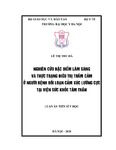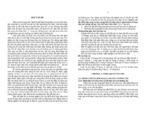
Please use this identifier to cite or link to this item:
http://dulieuso.hmu.edu.vn/handle/hmu/1815| Title: | Nghiên cứu đặc điểm lâm sàng và thực trạng điều trị trầm cảm ở người bệnh rối loạn cảm xúc lưỡng cực tại Viện Sức khoẻ Tâm thần |
| Authors: | Lê Thị Thu, Hà |
| Advisor: | PGS.TS. Nguyễn Kim, Việt PGS.TS. Trần Hữu, Bình |
| Keywords: | 62720148;Tâm thần |
| Issue Date: | 2018 |
| Abstract: | THÔNG TIN TÓM TẮT NHỮNG KẾT LUẬN MỚI . CỦA LUẬN ÁN TIẾN SĨ. Tên đề tài luận án: “Nghiên cứu đặc điểm lâm sàng và thực trạng điều trị trầm cảm ở người bệnh rối loạn cảm xúc lưỡng cực tại Viện Sức khoẻ Tâm thần”. Chuyên ngành: Tâm thần; Mã số: 62720148. Nghiên cứu sinh: LÊ THỊ THU HÀ Khóa học: NCS khoá 29. Người hướng dẫn: 1. PGS. TS. Nguyễn Kim Việt 2. PGS. TS. Trần Hữu Bình. Cơ sở đào tạo: Đại học Y Hà Nội. Những kết luận mới của luận án:. 1. Đặc điểm trầm cảm trong rối loạn cảm xúc lưỡng cực. Nhóm bệnh nhân có tiền sử gia đình mắc các bệnh tâm thần nội sinh chiếm một tỷ lệ đáng kể (rối loạn cảm xúc lưỡng cực: 11,7%, tâm thần phân liệt 7%). Bệnh thường khởi phát ở người trẻ dưới 25 tuổi (40,8%), giai đoạn đầu tiên chủ yếu là giai đoạn trầm cảm (54,9%). Số bệnh nhân có từ 3 giai đoạn trầm cảm chiếm 38,1%; thời gian kéo dài các giai đoạn trầm cảm dưới 6 tháng: 80%. Bệnh cảnh lâm sàng phần lớn là trầm cảm không điển hình: còn phản ứng cảm xúc: 63,4%, nhạy cảm với sự từ chối: 57,7%.. Các triệu chứng trầm cảm hỗn hợp cũng xuất hiện trong nhóm nghiên cứu: nói nhiều 22,5% (gặp nhiều hơn trong rối loạn cảm xúc lưỡng cực II); Các triệu chứng của lo âu, loạn thần >25%, có ý tưởng tự sát và toan tự sát 43,7%, cơn tức giận dễ bị kích thích 39,4% đều chiếm tỷ lệ cao.. Thực trạng điều trị trầm cảm trong rối loạn cảm xúc lưỡng cực. Hơn 90% bệnh nhân trong nghiên cứu được sử dụng phác đồ đa trị liệu. Sự phối hợp thuốc an thần kinh với chống trầm cảm chiếm >75%, các thuốc thường dùng nhất là quetiapin, sertralin và mirtazapin. Thuốc chỉnh khí sắc chỉ mới được chỉ định ở 67,6%, phổ biến nhất là valproat. Thời gian điều trị trung bình là 21,75±11,02 ngày. Sau 12 tháng theo dõi, nghiên cứu ghi nhận tỷ lệ tái phát/tái diễn cao: biểu hiện bằng giai đoạn trầm cảm 31,59%, tỷ lệ ít hơn ở hưng cảm nhẹ 2,88% và hưng cảm 4,29%. Các yếu tố liên quan đến sự tái phát, tái diễn bệnh bao gồm: tiền sử có ít nhất 3 giai đoạn trầm cảm, không dùng chỉnh khí sắc, kém hoặc không tuân thủ điều trị, chức năng cá nhân, nghề nghiệp, xã hội bị ảnh hưởng.. THẦY HƯỚNG DẪN PGS.TS. Nguyễn Kim Việt PGS. TS. Trần Hữu Bình NGHIÊN CỨU SINH Lê Thị Thu Hà SUMMARY OF THE NOVEL CONCLUSIONS OF THESIS. Thesis title: “Studying clinical features and treatment status of depression in patients with bipolar disorder at National Institute of Mental Health”. Specialty: Psychiatry Code: 62720148. Candidate: LE THI THU HA Class: 29th. Supervisors: 1. Associate Professor Nguyen Kim Viet, Ph.D. 2. Associate Professor Tran Huu Binh, Ph.D. Training setting: Hanoi Medical University. The novel conclusions of thesis:. 1. Clinical features of depression in bipolar disorder.The groups of patients with family history of bipolar disorder and schizophrenia accounted for 11.7% and 7% of study population, respectively. The proportion of patients with onset before the age of 25 years was 40.8%, of patients having the first episode being depression was 54.9%. The group of patients having at least 3 depressive episodes accounted for 38.1%; 80% patients had most depressive episodes lasting less than 6 months. The presence of atypical depressive symptoms was common (“talkative” 22.5%, higher rate in patients with bipolar disorder II). Symptoms of Anxiety, Psychotic features (>25%), suicidal ideations and attempts (43.7%), agitation and irritability (39.4%) all account for substantial percentage among study population.. 2. Treatment status of depression in bipolar disorder.Most of the participants were on polytherapy (>90%). The combination of antipsychotic(s) and antidepressant(s) was prescribed for more than 75% participants, the most commonly used medications were quetiapine, sertraline, and mirtazapine. Mood stabilizers were used in 67.6% of study population, the most prescribed was valproate. The average treatment duration was 21.75±11.02 days. After 12-month follow-up, 31.59% patients experienced relapse and/or recurrent depressive episode(s), hypomania and mania only presented in 2.88% and 4.29% participants, respectively. Our findings indicated some risk factors associated with relapse/recurrence including: non- or poor treatment adherence, having at least 3 previous depressive episodes, no mood stabilizer used, and personal, occupational, social functioning impairments SUPERVISORS Associate Professor. Associate Professor. PhD Nguyen Kim Viet PhD Tran Huu Binh CANDIDATE Le Thi Thu Ha . |
| URI: | http://dulieuso.hmu.edu.vn//handle/hmu/1815 |
| Appears in Collections: | Luận án (nghiên cứu sinh) |
Files in This Item:
| File | Description | Size | Format | |
|---|---|---|---|---|
| 359_LETHITHUHA-LtTamthan29.pdf Restricted Access | 1.87 MB | Adobe PDF |  Sign in to read | |
| 359_LeThiThuHa-ttTamthan29.pdf Restricted Access | 671.55 kB | Adobe PDF |  Sign in to read |
Items in DSpace are protected by copyright, with all rights reserved, unless otherwise indicated.